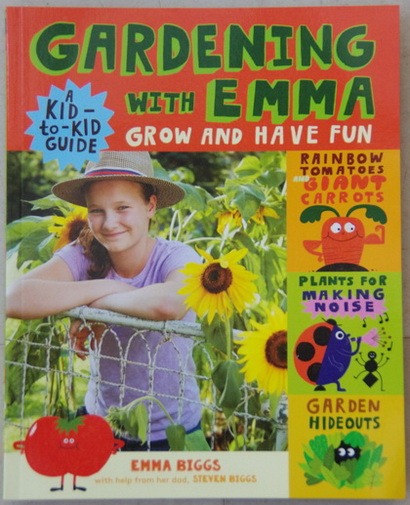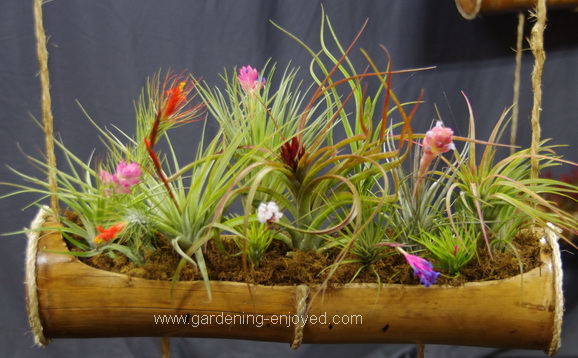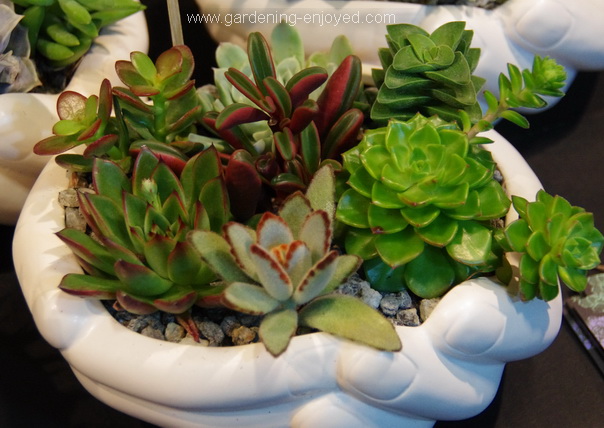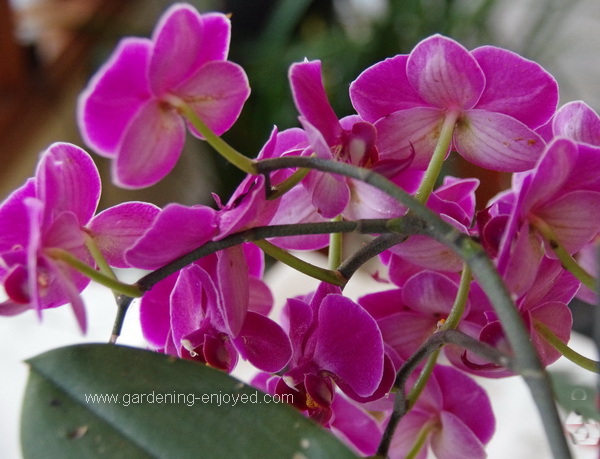
How did it become February already. It’s been a nice rest from sending you “Dallying” but a couple of things have transpired to excite me, once again, about gardening and writing. Last week a large envelope arrived in the post box and its contents were truly exciting. It wasn’t seeds or even a seed catalogue but rather it was a book. “Gardening With Emma” is a book that I have been anticipating for some time. Emma Biggs is the 13 year old daughter of a friend and fellow garden communicator and she is an amazing gardener and writer. Her just released book should inspire any kid, that sees it, to rush out and start buying seeds and bugging their parents for a plot of land to turn over this spring. The multitude of pictures and Emma’s kid friendly prose make this book a captivating read for any gardener. If you don’t fall into the child category but rather just a beginner in the vegetable gardening world then this book could also be just for you. Emma’s fascination
with her plants and the other aspects of her garden, soil, bugs, little brothers and weeds is truly infectious and I may have to acquire many copies to send to all of my grandchildren. Emma talks about strange plants, tiny plants, giant plants and plants that are fun for kids to grow because they make sounds, taste great or make great hiding spots in the garden. I have to admit that her passion for growing 100 varieties of Tomatoes does tend to make me feel a touch inadequate but I console myself with the thought that over the several years that I have known her I may have played a tiny part in inspiring her. Get each of the children in your life and even yourself a copy of Emma’s book at Gardening with Emma.

Strictly in the interest of research, the Assistant Gardener and I were forced to spend a few early January days in Florida. It was a hardship but I needed to find out what the latest ideas and trends were in the houseplant world. Tropical Plant International Exhibition is a giant trade show featuring most of the growers of the tropical plants that we northerners try to grow in our homes. Several GardenComm members, that’s the new name of the garden communicators association, were treated to a day long garden tour through S. Florida and then a couple of days meandering through this wonderful trade show. Many years ago when I was in the Interiorscape business, I loved a little known member of the fig family, Ficus lyrata the fiddle leaf fig. It has large wrinkled leaves that are about the shape of a fiddle. Apparently it is now all the rage for those who want a medium to large sized tree for their homes or offices. I was so far ahead of the curve. The hottest
trends in houseplants these days are much smaller and easier to take care of. They also come as complete pieces of home decor including the plant, an interesting container and sometimes devices or methods of hanging them or mounting them on walls. Tillandsia species were everywhere. They are commonly called air plants as they require no soil and will literally grow in the air with a bit of regular misting. They have been bred and developed to include a range of sizes and some interesting blooms and they are usually attached to some decorative structure. I even have one on a small piece of white plastic that is designed to be worn as a necklace.

Between all of the booths showing wonderful plants, I happened upon this exhibit. Yes, that is a solid piece of marble that has been cut to make an outdoor lounge. It was a visually arresting piece of furniture and it actually looked comfortable. I was offered the opportunity to try it out but I declined for fear that getting my aging body back out of it might have been a rather awkward challenge.
 Succulents in their many forms also were widely featured. The plant breeders and explorers have been busy adding shapes, textures and colours to the range of available plants. These again appeal to the modern busy family who really want to have some living plants in their homes but don’t want busy maintenance schedules. Most of these little delights don’t grow quickly and thus don’t require any transplanting skills of their owners. They are extremely tolerant of spasmodic watering schedules and survive in surprisingly moderate light situations. The beauty of them, as you can see in this photo, is in a small collection of different types where the contrast in textures makes a very interesting piece of horticultural art.
Succulents in their many forms also were widely featured. The plant breeders and explorers have been busy adding shapes, textures and colours to the range of available plants. These again appeal to the modern busy family who really want to have some living plants in their homes but don’t want busy maintenance schedules. Most of these little delights don’t grow quickly and thus don’t require any transplanting skills of their owners. They are extremely tolerant of spasmodic watering schedules and survive in surprisingly moderate light situations. The beauty of them, as you can see in this photo, is in a small collection of different types where the contrast in textures makes a very interesting piece of horticultural art.
 Back at home the snow is swirling around and record low temperatures have made me very selective about choosing ski days. The seed catalogues continue to arrive and entice me. The Amaryllis and Orchids are blooming wonderfully and brightening up some very gray days. Little things happen that fascinate me. Scale Insects like to make their homes on the hard leathery leaves of my Phalaenopsis Orchids and I regularly search for them armed with a cotton swab and a bit of alcohol. They tend to be rather fixed in one spot and spread very slowly to another spot by means of baby scale hatching from under the adults and crawling up the plant. How then is it possible for them to invade the flowers on these Orchids with such speed. The picture is the back side of the blooms where I have been
able to find several insects attached to each flower. These blooms have only been open a month or two and these nasty invaders have left their parents protection, crawled all the way up the bloom stalk and started to suck the life out of those lovely blooms. I find very few on the leaves but something about those blooms seems to accelerate their movement and multiplication. I will keep up the good fight. There may be more of them but I like to think that I can still outsmart them.
Back at home the snow is swirling around and record low temperatures have made me very selective about choosing ski days. The seed catalogues continue to arrive and entice me. The Amaryllis and Orchids are blooming wonderfully and brightening up some very gray days. Little things happen that fascinate me. Scale Insects like to make their homes on the hard leathery leaves of my Phalaenopsis Orchids and I regularly search for them armed with a cotton swab and a bit of alcohol. They tend to be rather fixed in one spot and spread very slowly to another spot by means of baby scale hatching from under the adults and crawling up the plant. How then is it possible for them to invade the flowers on these Orchids with such speed. The picture is the back side of the blooms where I have been
able to find several insects attached to each flower. These blooms have only been open a month or two and these nasty invaders have left their parents protection, crawled all the way up the bloom stalk and started to suck the life out of those lovely blooms. I find very few on the leaves but something about those blooms seems to accelerate their movement and multiplication. I will keep up the good fight. There may be more of them but I like to think that I can still outsmart them.
|

 Succulents in their many forms also were widely featured. The plant breeders and explorers have been busy adding shapes, textures and colours to the range of available plants. These again appeal to the modern busy family who really want to have some living plants in their homes but don’t want busy maintenance schedules. Most of these little delights don’t grow quickly and thus don’t require any transplanting skills of their owners. They are extremely tolerant of spasmodic watering schedules and survive in surprisingly moderate light situations. The beauty of them, as you can see in this photo, is in a small collection of different types where the contrast in textures makes a very interesting piece of horticultural art.
Succulents in their many forms also were widely featured. The plant breeders and explorers have been busy adding shapes, textures and colours to the range of available plants. These again appeal to the modern busy family who really want to have some living plants in their homes but don’t want busy maintenance schedules. Most of these little delights don’t grow quickly and thus don’t require any transplanting skills of their owners. They are extremely tolerant of spasmodic watering schedules and survive in surprisingly moderate light situations. The beauty of them, as you can see in this photo, is in a small collection of different types where the contrast in textures makes a very interesting piece of horticultural art.  Back at home the snow is swirling around and record low temperatures have made me very selective about choosing ski days. The seed catalogues continue to arrive and entice me. The Amaryllis and Orchids are blooming wonderfully and brightening up some very gray days. Little things happen that fascinate me. Scale Insects like to make their homes on the hard leathery leaves of my Phalaenopsis Orchids and I regularly search for them armed with a cotton swab and a bit of alcohol. They tend to be rather fixed in one spot and spread very slowly to another spot by means of baby scale hatching from under the adults and crawling up the plant. How then is it possible for them to invade the flowers on these Orchids with such speed. The picture is the back side of the blooms where I have been
able to find several insects attached to each flower. These blooms have only been open a month or two and these nasty invaders have left their parents protection, crawled all the way up the bloom stalk and started to suck the life out of those lovely blooms. I find very few on the leaves but something about those blooms seems to accelerate their movement and multiplication. I will keep up the good fight. There may be more of them but I like to think that I can still outsmart them.
Back at home the snow is swirling around and record low temperatures have made me very selective about choosing ski days. The seed catalogues continue to arrive and entice me. The Amaryllis and Orchids are blooming wonderfully and brightening up some very gray days. Little things happen that fascinate me. Scale Insects like to make their homes on the hard leathery leaves of my Phalaenopsis Orchids and I regularly search for them armed with a cotton swab and a bit of alcohol. They tend to be rather fixed in one spot and spread very slowly to another spot by means of baby scale hatching from under the adults and crawling up the plant. How then is it possible for them to invade the flowers on these Orchids with such speed. The picture is the back side of the blooms where I have been
able to find several insects attached to each flower. These blooms have only been open a month or two and these nasty invaders have left their parents protection, crawled all the way up the bloom stalk and started to suck the life out of those lovely blooms. I find very few on the leaves but something about those blooms seems to accelerate their movement and multiplication. I will keep up the good fight. There may be more of them but I like to think that I can still outsmart them.


